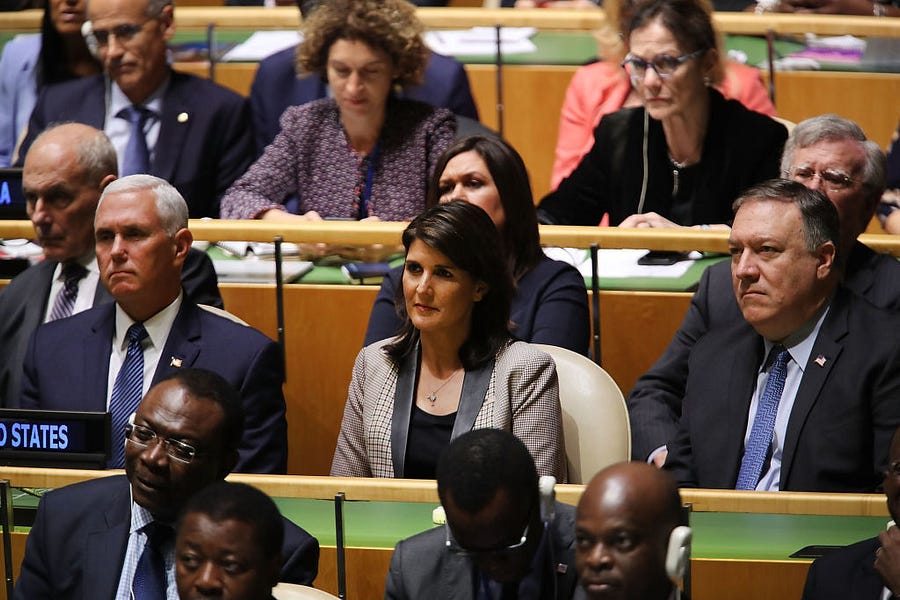And we’re back with more 2024 contenders! If you’re looking for some extra content, Chris and I talked to Chris Christie this week on the pod, who provided some of his own insights into how he sees the race shaping up.
This week we are looking at some of the folks who served in the Trump Administration and are considering a 2024 run to replace their old boss. It’s actually pretty unusual on the Republican side—Lamar Alexander in 1996 was the last cabinet secretary to run by my count.
The Formers
Nikki Haley: The Weather Vane
49 years old, former UN Ambassador
Nikki Haley’s presidential ambitions have been clear for some time, and she has the resumé to prove it. An accountant by trade, Haley has legislative experience from three terms in the South Carolina House of Representatives, executive experience from six years as governor, and foreign policy experience from nearly two years as ambassador to the United Nations during the Trump administration.
The daughter of Indian immigrants, Haley was the first woman and first non-white governor of South Carolina, elected on a wave of outsider, Tea Party energy. A pro-business fiscal conservative, she rose to national prominence in 2015 in the aftermath of the Mother Emanuel AME Church shooting in Charleston: She successfully pressured the state legislature to remove the Confederate flag from the grounds of the state capitol.
After harshly criticizing candidate Trump, Haley agreed to serve in his administration when he became president, establishing her credentials for a future presidential run, and was one of the few administration officials to leave on good terms after the 2018 midterms. But in the wake of January 6, she denounced the former president’s role in the insurrection, saying that “he’s lost any sort of political viability”—only to pirouette once again a few months later to say that she would support Trump in 2024 if he decides to run again, all while clearly laying the groundwork for a run of her own.
She “navigated the Trump era with a singular shrewdness,” but the problem for Haley is obvious: can she be Trumpy enough to win the 2024 GOP primary while remaining palatable to the moderate, suburban swing voters she naturally appeals to?
Strengths: She’s the triple threat—experience, instincts, work ethic. Her ability to maneuver during her time in the administration was like watching an Olympic figure skater—the artistry can make you forget the sheer athleticism on display.
Weaknesses: It’s rare to see a single magazine piece tank someone’s presidential campaign, but this write up by Tim Alberta in February—portraying her as someone whose ambition and paranoia trumps loyalty or consistency—stopped her momentum in its tracks and seemed to hand the ball to DeSantis at the exact wrong moment for Haley.
2024 Tea Leaves: No question she is running if Trump doesn’t, and she probably sees some advantages to drafting behind DeSantis as the focus of opposition research and media spotlight for a while too.
Mike Pence: The Tightrope Walker
62 years old, former Vice President
Who is President Trump’s heir apparent? For 99 percent of the Trump era, that answer seemed obvious: then-Vice President Mike Pence. The former Indiana governor and staunch social conservative had saved Trump’s skin back during the 2016 campaign by providing reassurance to then-skittish evangelical voters, then spent the next four years as Trump’s unflappable shadow—the stoic, self-effacing foil to his grandiose, manic boss.
Then the 2020 election happened. Over the excruciating two months between election day and the certification of Biden’s win, as Trump railed against a rigged contest and made it increasingly clear he demanded nothing less than absolute personal devotion from his allies on the issue, Pence walked a tightrope—refusing to call Joe Biden the president-elect, but declining to explicitly endorse claims of a stolen election either.
For the vice president, judgment day was January 6, the day he would need either to preside over the certification of Biden’s victory, or—at Trump’s urging, in defiance of the law—make a last-ditch procedural attempt to overturn it.
As a mob massed outside, Pence chose to do his job. It was probably the best possible moment to finally declare his independence—but it may still cost him his presidential shot. Trump remains the biggest kingmaker in a party that has largely decided to memory-hole the capitol riot, and he has not forgiven Pence’s final abandonment. As the riot unfolded, Trump tweeted that Pence “didn’t have the courage to do what should have been done,” and he has taken the time to attack him along similar lines every few months since.
Strengths: He has high name ID, untouchable conservative credentials, plenty of national experience, and can take credit for all of the Trump administration’s accomplishments.
Weaknesses: Trump continues to trash him, he’s not a dynamic speaker, and it’s hard to pinpoint who his base voter is when he is squeezed on both sides—literally at Trump’s side for four years and now without his support.
2024 Tea Leaves: I actually think Pence is the one guy who may not run, but he was in New Hampshire last month and Iowa this month and has kept a team in place.
Mike Pompeo: The Candidate
57 years old, former Secretary of State
Mike Pompeo’s shiny resumé was never in doubt. After West Point, a stint in the Army, Harvard Law School, a prestigious D.C. law firm, and running an aerospace business back in Kansas, he ran for and won a Kansas seat in the House, putting together a voting record consistently to the right even of his fellow Republicans.
Despite predicting Trump would be “an authoritarian President who ignored our Constitution,” Pompeo—who was little known outside of his role in the Benghazi hearings—was tapped for CIA director. And in a little over a year, Pompeo had clearly impressed his new boss. Trump fired Secretary of State Rex Tillerson by tweet and announced Pompeo as his replacement. As Secretary of State, he focused on Iran, met with Kim Jong Un, lauded Israel, and took a more aggressive posture toward China.
He also developed a reputation for being able to placate Trump. A former American ambassador described him to Susan Glassner at the New Yorker “like a heat-seeking missile for Trump’s ass.” And on November 10, 2020—two days after all major news networks had called the election for Biden—he even went so far as to tell reporters “there will be a smooth transition to a second Trump administration.” As the Washington Post put it, Pompeo’s time in the administration was “a careful balancing act designed to lay future claim to Trump’s large and loyal political base while retaining credibility among the GOP establishment.”
Strengths: He wants it. Really, really badly. That counts for something.
Weaknesses: State isn’t usually a great platform to run from because your expertise is the one thing it’s hard to get the American people jazzed about: foreign policy. Fun fact: The last Secretary of State to win the presidency was elected in 1856 and precipitated the Civil War. Pompeo has little name ID, no base voters, and no serious campaign experience.
2024 Tea Leaves: No one is running more than Pompeo. His midterm PAC has asked its supporters to call themselves “pipehitters” to the endless mockery and merriment of the internet. He is in overdrive trying to win over New York donors. He is literally zooming into events in New Hampshire while sitting in Iowa.
Operative View: Focus on Biden
This week, we’ve got some nuggets of wisdom from Alice Stewart, who was the communications director for the presidential campaigns of Senator Ted Cruz, Governor Mike Huckabee, Senator Rick Santorum and Congressman Michele Bachmann.
It’s early, but never too soon to get a temperature of the electorate. Anyone who feels the fire in the belly for 2024 should set up a PAC based on their key interests and issues in order to raise money and build a network of support. It’s not about grabbing headlines, it’s about making headway in key states of Iowa, New Hampshire, South Carolina, and Florida. Visit these states early and often.
Obviously, Donald Trump is the elephant in the room—don’t ignore it, but don’t trip over the trunk either. This means focusing on the policies that unite the GOP and not the personalities that divide us. The Biden administration has given the GOP plenty of material to work with in terms of their failed agenda, and focusing on that is the way to win in 2022 and 2024.
For those of you who are already tired of 2024 talk, it’s Stirewalt’s turn to weigh in on what he’s watching.
A Reality Check on Polling
The ongoing auto-da-fé by America’s pollsters in the wake of a better-than-expected performance by former President Donald Trump in 2020 continues apace. First in sackcloth and ashes came the pollsters who work for Democrats, and now arrive the rest of the penitents with the postmortem from the American Association for Public Opinion Research.
The sin was allegedly “wildly” inaccurate polling on the presidential election, a subject that has not just been the repeated object of Trump’s inexhaustible reservoir of splenetic rage but of great frustration for journalists who sometimes seem to be almost as upset as the former president himself. “The real catastrophe is that the failure of the polls leaves Americans with no reliable way to understand what we as a people think outside of elections,” wrote The Atlantic’s David Graham soon after the election, “which in turn threatens our ability to make choices, or to cohere as a nation.”
Holy moly! The whole point of the elections is so that we know what people think. Outside of those, unless you’re doing market research for a living, we don’t really need to know what people think. And it’s a good thing, too, since they often aren’t sure themselves what they really do think, and change their minds at the drop of a hat. Polls can be interesting, but they are not themselves particularly important. I write that as a person who has devoted much of my professional life to understanding polls and public opinion research. It’s fascinating stuff, but the polls are the scouting report, not the game itself.
Part of the reason so many journalists seem so upset about the problems with polling is how many of them overuse and abuse surveys. And they’re not letting up despite their disappointment with the 2020 results. Witness: Two of Trump’s former pollsters each recently released surveys that said Trump was dominating the 2024 field. Tony Fabrizio said his former client was “still the 800-pound gorilla,” with 47 percent of the primary vote. Jon McLaughlin said Trump “obliterates the field” with 55 percent. So what? Even if these surveys were done by objective pollsters, there’s basically no value in a poll this far in advance other than to know who is the most famous.
But when a Politico reporter goes to Iowa to assess former Vice President Mike Pence’s chances, not only does this kind of polling make it in, but so does a straw poll taken by attendees at CPAC, where Trump himself was the headline speaker and object of cultish levels of affection. That’s like taking a straw poll on favorite music groups at a BTS concert. In the old, old days, reporters would have to have hunches based on what insiders said, how they saw organizations performing, and what they knew about the electorate. The explosion in polling over the past 20 years created the false impression that every political opinion was fixed and knowable, and an unfortunate certitude crept in. Political forecasting at the very end of a campaign cycle is very data-driven. But three years out? It’s a lot of guesswork based on reporting and experience. You can pretty well ignore the presidential polls until we get past midterms. There just aren’t enough voters paying attention.
Another problem at the media-polling nexus are cheap-o polls designed to grub up newsy nuggets like this or this or, heaven help us, this. The pap that outfits like YouGov and Survey Monkey pump out—to say nothing of partisan chops shops like Data for Progress—are too easily confused with the real thing. Polls like these look like news, but are just a lazier version of the old man-on-the-street interview. Online surveys on clickbait subjects are no more revealing than stories where reporters just collect tweets, slap on a headline and go fishing for clicks.
There are real problems confronting political polling, especially on the state-level. Compounding the nationwide problem of Republicans becoming more and more reluctant to participate in polls, state-level surveys have their own challenges, including the erosion of geographic area codes as people keep cell phone numbers for life. Finding a geographically discrete sample that includes the right mix of voters has become very hard, indeed.
But let’s do keep things in perspective. An average of the final five high-quality national polls for 2020—these were live-interviewer non-partisan surveys with a sufficient mix of cell phones and landlines—underestimated Trump’s share of the national vote by 3.9 points. That was exactly the same estimation that the similar average produced in 2016. What made the difference seem greater this time was expectations. The average forecast in 2016 was for Trump to lose nationally by 2.8 points, but he only lost by 2.1 percent because while both he and Hillary Clinton outperformed expectations, Trump did a squidge better. In 2020, polls almost perfectly predicted Biden’s 51.3 percent of the national vote, but Trump again overperformed his anticipated share, reducing an 8.2-point polling spread to just 4.4 points in reality.
A similar average from 2012 reveals a 3.3-point gap between the expected margin and the final result. This year it was 3.9 points. It’s worth noting, and I certainly admire the professional devotion of the pollsters, but let’s stop it with the self-flagellation. What’s wrong with polling has more to do with how it’s used than how it’s done.









Please note that we at The Dispatch hold ourselves, our work, and our commenters to a higher standard than other places on the internet. We welcome comments that foster genuine debate or discussion—including comments critical of us or our work—but responses that include ad hominem attacks on fellow Dispatch members or are intended to stoke fear and anger may be moderated.
With your membership, you only have the ability to comment on The Morning Dispatch articles. Consider upgrading to join the conversation everywhere.